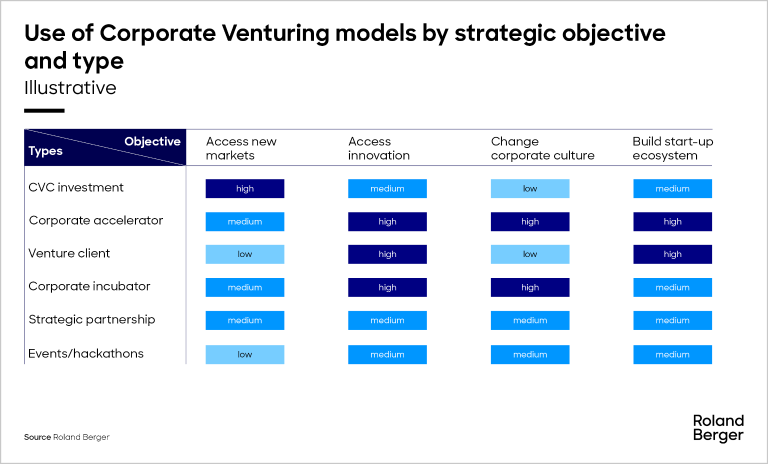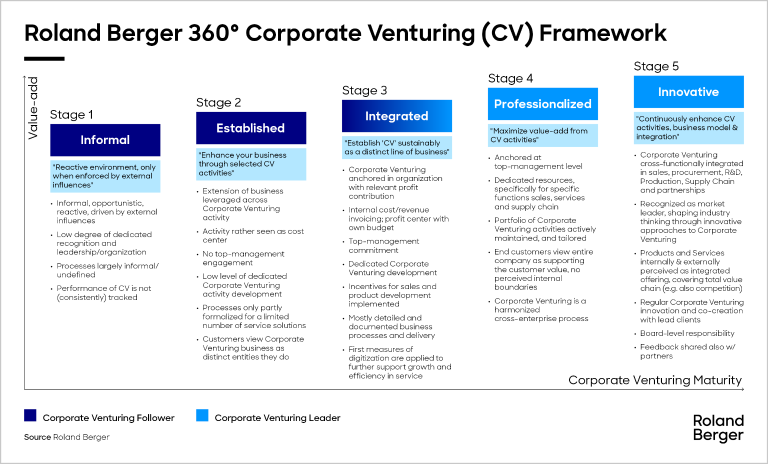For making the right investment decisions investors can rely on the decade long profound industrial and functional expertise provided by our global transaction team.


Corporate Venturing
A path to ensure access and accelerate innovation
Pressure on companies is rising to ensure access to innovation while at the same time focusing on their day-to-day operations. Achieving this balance can be critical for longer-term success, yet it poses a significant challenge to many companies – especially in today's environment of growing global uncertainty. The answer for many lies in corporate venturing (CV), whereby the corporation invests directly in external startup companies, whether in the form of financing, helping with strategy or providing operational support. We examine the different types of corporate venturing, key factors and hurdles for success, and how Roland Berger can help players choose the right type of engagement.

"The key to long-term success is balancing day-to-day operations with the ability to innovate. Choosing the right collaboration format is crucial – at the end of the day you need to create a win-win situation."
A variety of models
Many different types of corporate venturing exist, each requiring different resources and suitable for different phases of innovation. For example, corporate incubators can effectively generate new ideas and take them to startup level, while a "venture client" model – where the company buys and uses strategically important solutions from a startup, usually without investing in the startup itself – can continue the process through to the scale-up stage. The relationship between the two parties in corporate venturing is always symbiotic: The startup receives financial support, access to infrastructure, in-house R&D capabilities or customers, say, while the corporation benefits from the startup's innovation capabilities. Indeed, creating a win-win situation for both parties is crucial for success.
How can corporations choose the right type of corporate venturing for them? The answer lies in their specific strategic objective. For example, if their strategic objective is to access new markets, they will need a higher level of control over the startup, maybe using tools such as direct investment. If, on the other hand, they want to enliven their own corporate culture, setting up a corporate incubator can enable closer interaction between the corporation and the startups it invests in, leading to the corporation itself becoming more innovative and entrepreneurially-minded.

"Corporate Venturing can be a catalyst for innovation, unlocking new growth opportunities. The choice for the right format, however, depends on individual strategic targets that need to be supported by top management."
Success factors and hurdles
Key success factors for corporate venturing include ensuring proximity to top management within the corporation, aligning on how to define and measure success, and selecting a corporate venturing team that combines internal experience with an external perspective – for example, a background in innovation or previous experience running a startup. Corporations are also prey to a number of pitfalls. For example, there is a temptation for companies to set overly ambitious financial targets early on, rather than focusing on encouraging creativity in the initial stages. It is also important for corporations to understand their own level of maturity with regard to corporate venturing. While a lower level of maturity does not necessarily prevent the company accessing innovation, it may steer it towards certain types of corporate venturing, such as strategic partnerships.
Roland Berger 360° Corporate Venturing Framework
We have an extensive toolkit that we employ to help companies assess their level of maturity with regard to corporate venturing. With our 360° Corporate Venturing Framework, we can evaluate which type of corporate venturing they should engage in right now, by looking at both internal factors (organization, processes, responsibilities) and external aspects (market intelligence, competitor knowhow, customer excellence). But we can also use the Framework to look forward, identifying which steps the corporation should take so that it is in a position to benefit from other types of corporate venturing in the future – and can so become a leader rather than a follower.

Interested?
To discuss how your corporation can become a leader in corporate venturing, please reach out to one of our experts below.
Register now to gain access to the comprehensive study on “Corporate Venturing – A path to ensure access and accelerate innovation” to get to know the most significant insights and developments in the world of corporate venturing.
We also thank Prof. Dr. Dominik Kanbach for his valuable contribution and the cooperation between Roland Berger and the HHL Leipzig Graduate School of Management.








